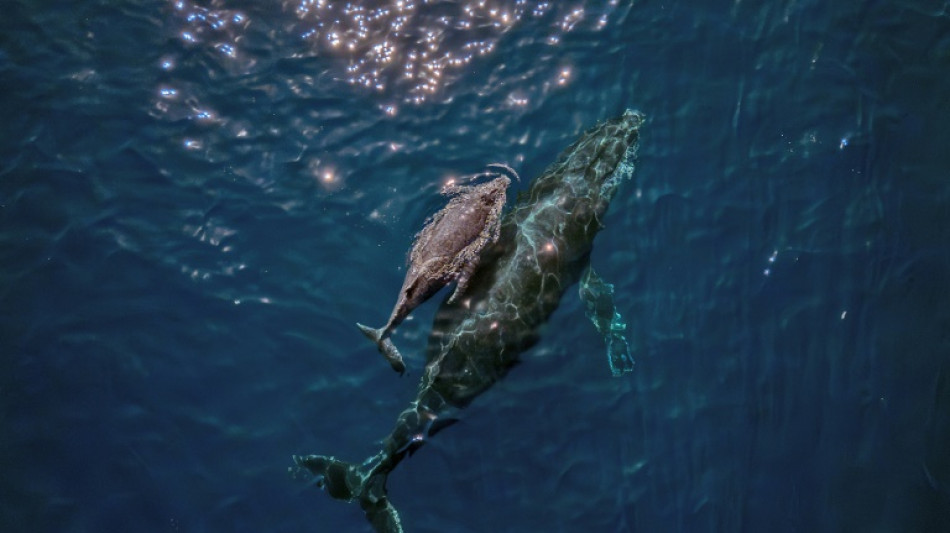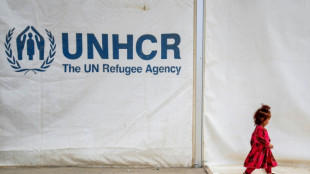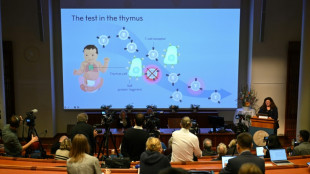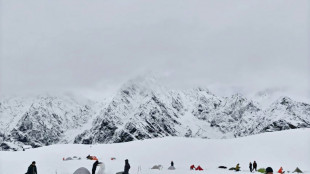
-
 EU channels Trump with tariffs to shield steel sector
EU channels Trump with tariffs to shield steel sector
-
Labuschagne out as Renshaw returns to Australia squad for India ODIs

-
 Open AI's Fidji Simo says AI investment frenzy 'new normal,' not bubble
Open AI's Fidji Simo says AI investment frenzy 'new normal,' not bubble
-
Tokyo stocks hit new record as Asian markets extend global rally

-
 Computer advances and 'invisibility cloak' vie for physics Nobel
Computer advances and 'invisibility cloak' vie for physics Nobel
-
Nobel literature buzz tips Swiss postmodernist, Australians for prize

-
 Dodgers hold off Phillies to win MLB playoff thriller
Dodgers hold off Phillies to win MLB playoff thriller
-
China exiles in Thailand lose hope, fearing Beijing's long reach

-
 Israel marks October 7 anniversary as talks held to end Gaza war
Israel marks October 7 anniversary as talks held to end Gaza war
-
Indians lead drop in US university visas

-
 Colombia's armed groups 'expanding,' warns watchdog
Colombia's armed groups 'expanding,' warns watchdog
-
Shhhh! California bans noisy TV commercials

-
 Trump 'happy' to work with Democrats on health care, if shutdown ends
Trump 'happy' to work with Democrats on health care, if shutdown ends
-
Trump says may invoke Insurrection Act to deploy more troops in US

-
 UNESCO board backs Egyptian for chief after US row
UNESCO board backs Egyptian for chief after US row
-
Unreachable Nobel winner hiking 'off the grid'

-
 Retirement or marketing gimmick? Cryptic LeBron video sets Internet buzzing
Retirement or marketing gimmick? Cryptic LeBron video sets Internet buzzing
-
CAF 'absolutely confident' AFCON will go ahead in protest-hit Morocco

-
 Paris stocks slide amid French political upheaval, Tokyo soars
Paris stocks slide amid French political upheaval, Tokyo soars
-
EU should scrap ban on new combustion-engine sales: Merz

-
 US government shutdown enters second week, no end in sight
US government shutdown enters second week, no end in sight
-
World MotoGP champion Marquez to miss two races with fracture

-
 Matthieu Blazy reaches for the stars in Chanel debut
Matthieu Blazy reaches for the stars in Chanel debut
-
Macron gives outgoing French PM final chance to salvage government

-
 Illinois sues to block National Guard deployment in Chicago
Illinois sues to block National Guard deployment in Chicago
-
Exiled Willis succeeds Dupont as Top 14 player of the season

-
 Hamas and Israel open talks in Egypt under Trump's Gaza peace plan
Hamas and Israel open talks in Egypt under Trump's Gaza peace plan
-
Mbappe undergoing treatment for 'small niggle' at France camp: Deschamps

-
 Common inhalers carry heavy climate cost, study finds
Common inhalers carry heavy climate cost, study finds
-
Madagascar president taps general for PM in bid to defuse protests

-
 UEFA 'reluctantly' approves European league games in US, Australia
UEFA 'reluctantly' approves European league games in US, Australia
-
Hundreds protest in Madagascar as president to announce new premier

-
 Greta Thunberg lands in Greece among Gaza flotilla activists deported from Israel
Greta Thunberg lands in Greece among Gaza flotilla activists deported from Israel
-
UNESCO board backs Egyptian ex-minister for top job: official

-
 Facing confidence vote, EU chief calls for unity
Facing confidence vote, EU chief calls for unity
-
Cash-strapped UNHCR shed 5,000 jobs this year

-
 Mbappe to have 'small niggle' examined at France camp: Deschamps
Mbappe to have 'small niggle' examined at France camp: Deschamps
-
Brazil's Lula asks Trump to remove tariffs in 'friendly' phone call

-
 'Terrible' Zverev dumped out of Shanghai by France's Rinderknech
'Terrible' Zverev dumped out of Shanghai by France's Rinderknech
-
What are regulatory T-cells? Nobel-winning science explained

-
 OpenAI signs multi-billion dollar chip deal with AMD
OpenAI signs multi-billion dollar chip deal with AMD
-
Salah under fire as Liverpool star loses his spark

-
 Paris stocks drop as French PM resigns, Tokyo soars
Paris stocks drop as French PM resigns, Tokyo soars
-
ICC finds Sudan militia chief guilty of crimes against humanity

-
 Zverev dumped out of Shanghai Masters by France's Rinderknech
Zverev dumped out of Shanghai Masters by France's Rinderknech
-
One hiker dead, hundreds rescued after heavy snowfall in China

-
 Hundreds stage fresh anti-government protests in Madagascar
Hundreds stage fresh anti-government protests in Madagascar
-
Feminist icon Gisele Pelicot back in court as man appeals rape conviction

-
 US government shutdown enters second week
US government shutdown enters second week
-
Kasatkina ends WTA season early after hitting 'breaking point'


Back from the brink: the migratory species on the road to recovery
While a landmark new report on the world's threatened migratory species is a catalogue of decline and destruction, the handful of animals staging a comeback shows improvement is possible -- if humans change their ways.
From the majestic humpback whale launching into the air from the waves, or the thousands of snub-nosed saiga antelope fanning across the steppes of Central Asia. These sights would have been barely possible without the concerted conservation efforts that have helped these species rebuild populations.
The State of the World's Migratory Species assessment, published Monday, found that animals, fish, birds and reptiles listed for protection under the UN Convention on the Conservation of Migratory Species of Wild Animals (CMS) were seeing declines across the world.
Around 70 of the threatened species saw their conservation status worsen between 1988 and 2020.
But 14 have shown an improvement, it found. Here are some of those recovering species:
- Humpback whales -
For hundreds of years, whalers from across the planet hunted humpback whales for their oil, meat, and baleen -- their feeding filtration system.
According to the International Union for Conservation of Nature (IUCN) they were targeted by early hunters in their wintering areas near the West Indies and Cape Verde, then near their summer feeding grounds from the 1860s, especially off Iceland and Norway. In the Pacific they were hunted particularly by Japanese whalers.
By 1986, the IUCN had listed the species as globally endangered.
International restrictions on commercial whaling allowed the humpback whale population to rebound and today, more than 80,000 mature individuals navigate throughout the world's oceans.
While some subpopulations have now recovered more than 90 percent of their pre-whaling numbers, the CMS report said other smaller groupings like the humpbacks in the Arabian Sea, were still endangered.
Continuing threats include from fishing gear, underwater noise pollution, and collisions with ships.
- Vicuna -
Vicunas, a llama-like creature that roams wild in parts of Argentina, Bolivia, Ecuador, Chile, Peru, is one of the few undomesticated animals sought for its wool.
Illegal poaching brought vicunas to the brink of extinction.
Numbers are now increasing thanks to legal protection from hunting, an international trade ban and education initiatives and the vicuna conservation status has changed from near threatened to least concern.
But threats from poaching for the illegal market, habitat encroachment and climate change remain.
- Lesser Kestrel -
The lessekestrel was once one of the most abundant small, migratory birds of prey that could befound from Spain to southern Russia to China.
The use of pesticides, especially DDT from the 1940s to 1970s, poisoned the birds directly and caused a drastic reduction in prey.
Habitat loss from urbanisation and agricultural intensification also caused severe population declines throughout Europe.
Since the 1980s, targeted conservation efforts -- like providing artificial nests, restoring breeding colonies, and releasing captive-bred birds into the wild -- have helped boost populations in southwestern Europe.
- Saiga Antelope -
National and international conservation efforts helped bring the Saiga Antelope back from the brink of extinction.
The revival of Kazakhstan's steppe and wetland habitats, projects to reintroduce native species and efforts to work with local communities to address overexploitation all played a role in their recovery.
Its population in Kazakhstan rebounded from a perilous low of 50,000 individuals in 2006, to over 1.3 million in 2022.
The species has now partially resumed migration into Uzbekistan.
- Black-Faced Spoonbill -
The black-faced spoonbill is a migratory seabird found in North and South Korea, China, Russia, Japan, Vietnam, Cambodia, Thailand, and the Philippines.
These white wading birds travel along a restricted migration route for breeding and wintering.
Their habitat has come under threat from growing human populations and agricultural and industrial development, while the birds face pesticide pollution, hunting, and the collection of eggs from nesting sites.
But legal protections, the designation of breeding sites as seabird sanctuaries and wetland restoration projects have all helped to improve the species' status from critically endangered to endangered.
H.Gerber--VB


